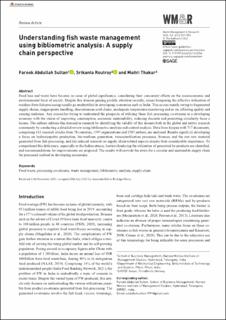| dc.contributor.author | Sultan, Farook Abdullah | |
| dc.contributor.author | Routroy, Srikanta | |
| dc.contributor.author | Thakur, Maitri | |
| dc.date.accessioned | 2023-06-19T08:58:21Z | |
| dc.date.available | 2023-06-19T08:58:21Z | |
| dc.date.created | 2022-11-18T14:10:14Z | |
| dc.date.issued | 2022 | |
| dc.identifier.citation | Waste Management & Research. 2022, 1-23. | en_US |
| dc.identifier.issn | 0734-242X | |
| dc.identifier.uri | https://hdl.handle.net/11250/3072005 | |
| dc.description.abstract | Food loss and waste have become an issue of global significance, considering their concurrent effects on the socioeconomic and environmental facet of society. Despite this domain gaining prolific attention recently, issues hampering the effective utilization of residues from fish processing usually go unidentified in developing economies such as India. This occurs mainly owing to fragmented supply chains, inappropriate handling, discontinuous cold chains, inadequate temperature monitoring and so on, affecting quality and causing underuse. Any researcher trying to understand the prospects of utilizing these fish processing co-streams in a developing economy with the vision of improving consumption, economic sustainability, reducing discards and promoting circularity faces a lacuna. The authors address this demand in research by identifying the validity of this domain both in the global and native research community by conducting a detailed review using bibliometric analysis and content analysis. Data from Scopus with 717 documents, comprising 612 research articles from 78 countries, 1597 organizations and 2587 authors, are analysed. Results signify (i) developing a focus on hydroxyapatite production, bio-methane generation, transesterification processes, biomass and the rest raw material generated from fish processing, and (ii) reduced research on supply chain-related aspects despite their considerable importance. To comprehend this deficiency, especially in the Indian stance, barriers hindering the utilization of generated by-products are identified, and recommendations for improvements are proposed. The results will provide the struts for a circular and sustainable supply chain for processed seafood in developing economies. | en_US |
| dc.language.iso | eng | en_US |
| dc.publisher | Sage | en_US |
| dc.rights | Navngivelse-Ikkekommersiell 4.0 Internasjonal | * |
| dc.rights.uri | http://creativecommons.org/licenses/by-nc/4.0/deed.no | * |
| dc.subject | Food waste | en_US |
| dc.subject | Processing co-streams | en_US |
| dc.subject | Waste management | en_US |
| dc.subject | Bibliometric analysis | en_US |
| dc.subject | Supply chain | en_US |
| dc.title | Understanding fish waste management using bibliometric analysis: A supply chain perspective | en_US |
| dc.title.alternative | Understanding fish waste management using bibliometric analysis: A supply chain perspective | en_US |
| dc.type | Journal article | en_US |
| dc.type | Peer reviewed | en_US |
| dc.description.version | publishedVersion | en_US |
| dc.rights.holder | © The Author(s) 2022. Creative Commons License (CC BY-NC 4.0) This article is distributed under the terms of the Creative Commons Attribution-NonCommercial 4.0 License (https://creativecommons.org/licenses/by-nc/4.0/) which permits non-commercial use, reproduction and distribution of the work without further permission provided the original work is attributed as specified on the SAGE and Open Access page (https://us.sagepub.com/en-us/nam/open-access-at-sage). | en_US |
| dc.source.pagenumber | 1-23 | en_US |
| dc.source.volume | 41 | en_US |
| dc.source.journal | Waste Management & Research | en_US |
| dc.source.issue | 3 | en_US |
| dc.identifier.doi | 10.1177/0734242X221122556 | |
| dc.identifier.cristin | 2076453 | |
| cristin.ispublished | true | |
| cristin.fulltext | original | |
| cristin.qualitycode | 1 | |

